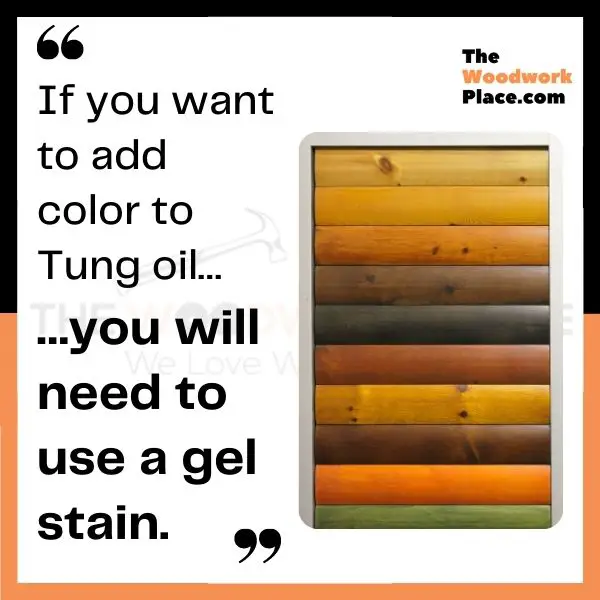Tung oil is a natural drying oil that preserves wood grain both inside and out. Food safe (once cured), this Tung tree oil extract doesn’t yellow or darken over time.
But, what if you want to add a bit of color to this otherwise transparent finish?
Oil-based wood stain will blend into a pure Tung oil finish.
However, pure Tung oils slow-drying nature means mixing it with any fast-drying stain may create application issues later on. In short, you should avoid mixing pure Tung oil with oil-based wood stain.
So, what can you do if you want to make Tung oil darker?
Well, in this post you will find out why trying to make a Tung Oil + Wood Stain mixture is often a recipe for disaster. And you will discover what special type of stain will work on a pure Tung oil finish (even after it’s cured).

This post may contain affiliate links to products that we receive a commission for (at no additional cost to you). Learn more here.
First Off, Can You Simply Put Oil Based Stain Over Tung Oil?
Wood stains act like oil finishes, in that they both need to penetrate wood grain to really work.
And so, if a pure Tung oil coat has dried and/or cured, then it will have sealed over those open wood pores. Which means, there is no opportunity for wood stain to sink into that timber.
In other words, you can’t add a penetrating wood stain over a Tung oil finish.
Related Post: Can You Apply Epoxy Over A Tung Oil Finish?
What About The Reverse? Can You Apply Tung Oil Over Wood Stain?
No can do, unfortunately. The same problem raises it’s ugly head again here too. Tung oil needs to sink into wood. And wood stain will have already saturated that timber surface.
What’s more, oil-based wood stains also leave behind a solid resin coat that seals over the grain.
A wood stain resin coat isn’t waterproof, or even all that water resistant. But, it is more than enough to prevent thick Tung oil from evenly soaking into that lumber.
Related Post: Can You Stain Over Oiled Wood? (The Top 5 Oil Finishes Examined)
Will Tung Oil At Least Naturally Darken Wood Over Time?
Pure Tung oil does not darken wood. This clear coating finish doesn’t discolor lumber, neither will it yellow over time.
However, a lot of Tung oil marketed products aren’t actually pure Tung oil.
These not-Tung oils are made from a polyurethane + Tung oil blend. Other times they are little more than a thinned out varnish (plus other dryers). And, fairly often, they don’t even contain any Tung oil at all.
Which means that if you’ve noticed your Tung oil coated wood craft darkening, then the oil product you used was not a pure Tung oil product.
Now, for the purposes of this article, we have ignored these not-Tung/Tung-blend oil finishes. That is because the ingredients contained in these products can vary wildly.
So, once again, for the purposes of this article, we are only focusing on pure Tung oil finishes.
If you want to work with a 100% pure Tung oil wood finish, then get yourself a can of Liberons Pure Tung Oil. This premium natural product does not have any dryers added to it.
You can check out the latest prices for Liberons Pure Tung Oil over on Amazon.

Can You Mix Or Tint Pure Tung Oil With An Oil Based Stain?
You can tint pure Tung oil with stain, but it depends on what type of binder has been added to your wood stain product.
You see, penetrating oil wood stains are generally made up of two things; pigments and binders.
The pigment adds the color tint to wood. And the binder is there to make sure that the pigment remains fixed in place on the wood itself.
Now, there are many different types of binders used in stain products.
For example, some stain products might use a boiled linseed oil binder. Others use a varnish binder. And many others even use a polyurethane binder.
And here’s the tricky thing; each one of those different binders all have their own particular drying/curing times.
In the case of the very popular varnish stains, the varnish binders in them can dry in as little as 2-6 hours.
However, when it comes to pure Tung oil, this slow drying oil needs 24-48 hours to properly dry between coats.
So, if you blend Tung oil with a fast drying wood stain product, (such as a Varnish Stain), you will have a mismatched recipe. In other words, half of that Stain/Tung mixture will be drying much faster than the other half.
And this creates a problem later on, especially when you need to apply multiple coats of Tung oil.
That is because the varnish binder in the 1st initial coat of Stain/Tung oil blend will dry too quickly – and seal over that wood grain. And this will prevent a 2nd (and/or a 3rd) coat of the blend from evenly sinking into the wooden surface afterwards.
Does Tung Oil Get Darker With Each Coat? Pure Tung oil doesn’t darken wood, no matter how many extra coats you add.
So, What Can You Do To Darken Tung Oiled Wood?!
Well, what will work to darken Tung oil finishes is something called Gel Stain.
Gel stains don’t need to sink into wood, because they act more like a coat of paint. They sit and dry on the surface. And this is how they add a coat of color.
This is the single best way to ‘stain’ a Tung oil finish.

And How Long After Tung Oil Can You Apply Gel Stain?
Always wait for Tung oil to finish curing before you add anything onto it… including a gel stain.
Tung oil takes 1+ days to dry (depending on the room temperature). When Tung oil dries, it turns from its liquid form into a solid (but still soft) film.
However, it can take up to 30 days for Tung oil to cure. And when Tung oil cures, it turns from a solid film into a hard durable resin coat.
Once that Tung coat is cured, it’s ready for gel stain.
Related Post: Tung Oil Not Drying? (3 Simple Ways To Fix It)
I Really Want To Use Oil Stain! But That Tung Oil Has Already Dried.
If you’ve already coated on Tung oil, you have no choice here… you will need to remove the Tung oil finish first.
This involves using turpentine to soften the Tung oil, enough so that you can then scrape it off with 0000 fine steel wool.
Once you’ve got back down to the bare surface, you can then apply wood stain directly onto it.
To Sum Up, Here Are Your 3 Main Takeaways…
- 1). Tung oil and oil-based stain will blend together. However, their clashing drying times will create application issues.
- 2). If you want to add color to Tung oil, you will need to use a gel stain.
- 3). Otherwise, if that Tung oil has cured, you will need to completely remove it in order to apply oil-based stain onto bare wood.



